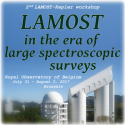Speaker
Prof.
Sofia Feltzing
(Lund Observatory)
Description
The Milky Way was for a long time regarded as a relatively well-understood and almost static entity with fixed stellar populations. However, starting in around 1990 we have found that the Milky Way stellar structure is very diverse and indeed very dynamic. The European Hipparcos satellite clearly showed how intricately the stars move in the solar neighbourhood. With Gaia’s first full data release coming in 2018 we are sitting on the brink of a revolution in Milky Way studies. However, Gaia on its own is not enough for understanding the nature of the stars or their full 3D movements. For that we need stellar spectra to characterize the stars and to obtain the radial velocities. This can be done from ground-based observations.
LAMOST is a major spectroscopic survey encompassing most stellar components of the Milky Way. In this talk I will contrast LAMOST with future large spectroscopic surveys and discuss how the data from these surveys can be combined with Gaia data to deepen our understanding of the Milky Way as a galaxy. I will in particular compare with 4MOST, WEAVE and DESI.
Primary author
Prof.
Sofia Feltzing
(Lund Observatory)

